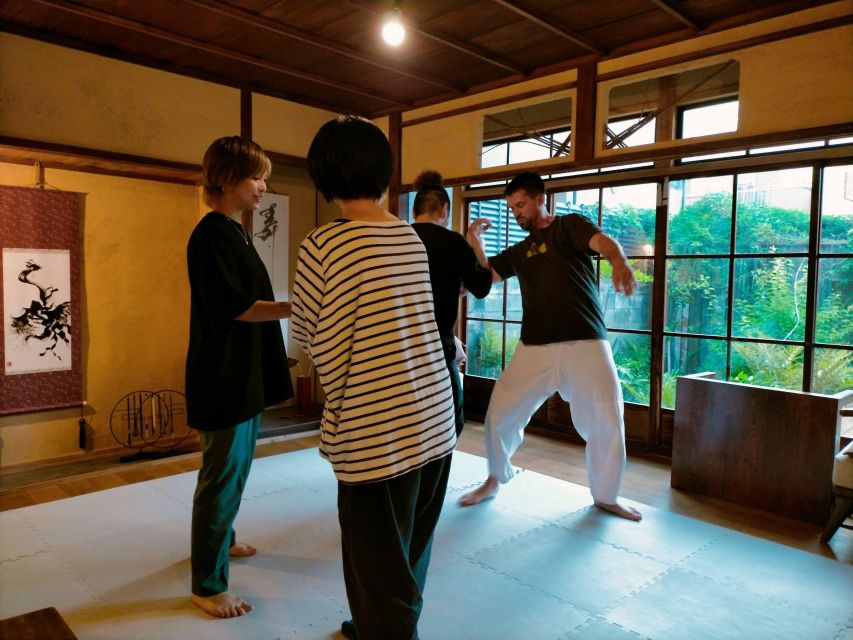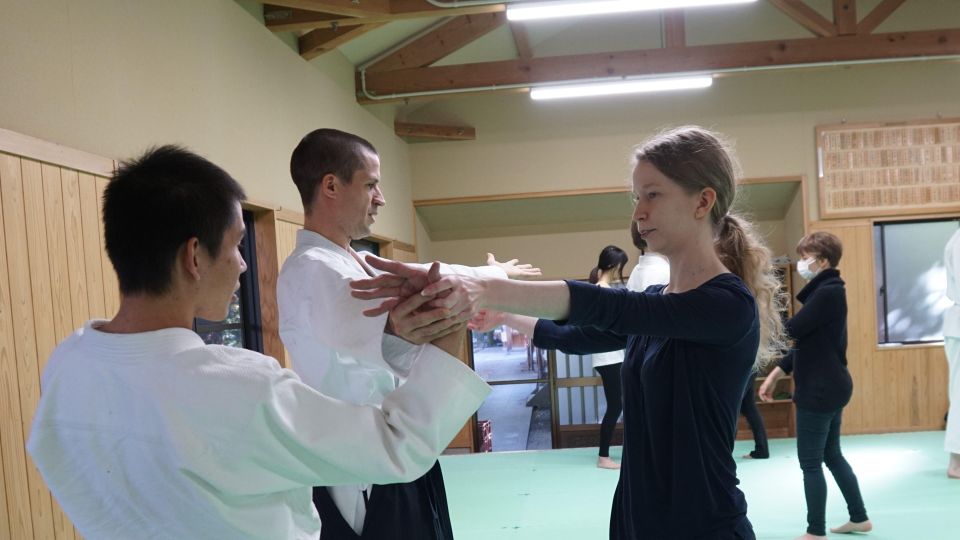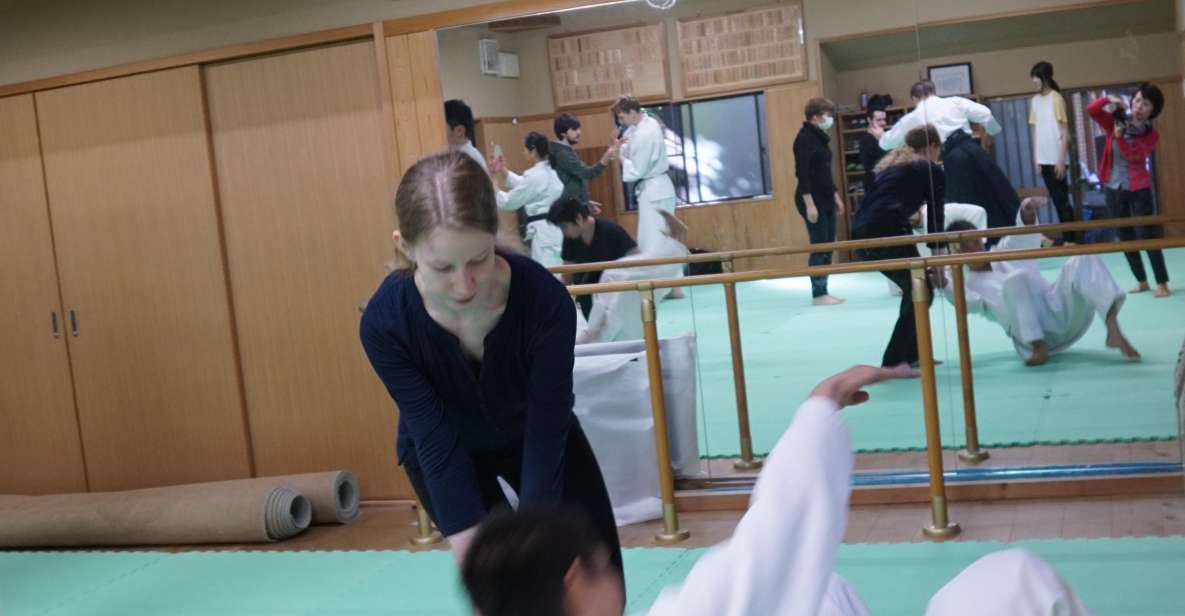Aikido, a traditional Japanese martial art, is a discipline focused on blending with an opponent’s energy to redirect their attacks. With a rich history rooted in self-defense techniques, Aikido emphasizes harmonious movements and non-aggressive strategies.
Here’s a concise and informative introduction to Aikido, exploring its principles, benefits, and application in self-defense and everyday life.
Led by a 5th Level Aikido Black Belt, workshops offer participants the opportunity to learn effective techniques, enhance strength and stability, and gain insights into the world of Japanese martial arts.
Good To Know

- Aikido originated in Japan in the early 20th century and was developed by Morihei Ueshiba.
- Aikido techniques focus on redirecting an opponent’s energy and emphasize non-aggression and non-resistance.
- Aikido offers physical and mental health benefits, including improved flexibility, strength, coordination, and reduced stress.
- Aikido principles can be applied to daily life situations, promoting effective communication, conflict resolution, and a mindset of continuous self-improvement.
Origins and History

Aikido originated in Japan and has a rich history dating back to the early 20th century. Developed by Morihei Ueshiba, it is a martial art that focuses on using an opponent’s energy and movements against them, rather than relying on brute force.
Aikido techniques include joint locks, throws, and pins, which allow practitioners to neutralize an attacker without causing severe harm. Throughout its history, Aikido has gained popularity worldwide and has been practiced by many famous martial artists such as Kenji Tomiki, Koichi Tohei, and Seigo Yamaguchi.
These practitioners have contributed to the development and promotion of Aikido as a martial art and have showcased its effectiveness both in self-defense situations and as a means of personal growth and spiritual development.
Principles and Philosophy

Continuing from the origins and history of Aikido, the principles and philosophy of this Japanese martial art emphasize the harmonious blending of energy and the redirection of an opponent’s force. Aikido principles are rooted in the mind-body connection, focusing on the integration of mental and physical aspects to achieve effective techniques. Central to Aikido is the concept of Ki energy utilization, which involves harnessing and directing one’s inner energy for both defensive and offensive purposes. This enables practitioners to maintain a calm and centered state while executing techniques, allowing them to effortlessly redirect an opponent’s force without relying on brute strength. By cultivating a deep understanding of the mind-body connection and harnessing the power of Ki energy, Aikido practitioners can achieve effective self-defense techniques while maintaining a sense of harmony and non-aggression.
| Aikido Principles | Mind-Body Connection | Ki Energy Utilization |
|---|---|---|
| Description | Integration of mental and physical aspects for effective techniques | Harnessing and directing inner energy for defensive and offensive purposes |
| Importance | Allows practitioners to maintain a calm and centered state while executing techniques | Enables redirection of an opponent’s force without relying on brute strength |
| Benefits | Enhances overall physical and mental well-being | Facilitates effective self-defense techniques while maintaining harmony and non-aggression |
| Application | Applied in training and everyday life | Utilized in techniques to achieve optimal results |
Techniques and Training
One fundamental aspect of Aikido is the mastery of various techniques through rigorous training. Aikido techniques encompass a wide range of movements, including throws, joint locks, and immobilizations, which are designed to redirect and neutralize an opponent’s energy. These techniques emphasize blending with an attacker’s movements rather than using brute force, making Aikido suitable for practitioners of all ages and physical abilities.
Aikido training is typically structured and disciplined, focusing on the development of proper body movement, balance, and timing. Advanced training methods in Aikido often involve practicing with multiple attackers, allowing practitioners to refine their skills in real-life scenarios.
Along With physical techniques, Aikido training also includes the study of Aikido principles and philosophy, which emphasize harmony, non-resistance, and the peaceful resolution of conflicts.
Benefits and Advantages
There are several key benefits and advantages to practicing Aikido. This Japanese martial art offers numerous health benefits, both physical and mental. Aikido helps improve flexibility, strength, and cardiovascular fitness. It also enhances coordination, balance, and posture. Additionally, Aikido promotes mental focus and concentration, as practitioners learn to stay present and centered during training.
To further illustrate the benefits of practicing Aikido, the following table provides a visual representation:
| Aikido Health Benefits | Aikido for Mental Focus |
|---|---|
| Improves flexibility | Enhances concentration |
| Builds strength | Promotes mindfulness |
| Increases cardiovascular fitness | Develops mental discipline |
| Enhances coordination and balance | Improves focus and awareness |
| Improves posture | Reduces stress and anxiety |
Aikido in Self-Defense
Aikido’s practical application can be found in self-defense situations. Aikido techniques are designed to neutralize an opponent’s attack by redirecting their energy and using their own momentum against them. This martial art focuses on blending with the attacker’s movements and using joint locks, throws, and pins to control and subdue them.
Aikido is particularly suitable for beginners because it emphasizes using the opponent’s force rather than relying on physical strength. By learning Aikido, beginners can develop effective self-defense skills, improve their balance and coordination, and gain self-confidence.
Aikido’s principles can also be applied in everyday life, promoting harmony, non-aggression, and a peaceful resolution of conflicts. Overall, Aikido offers practical self-defense techniques that are accessible to beginners and can be used in real-life situations.
Aikido in Everyday Life
The practical application of Aikido extends beyond self-defense situations and can be seamlessly integrated into various aspects of everyday life. Aikido principles can be applied to enhance physical fitness and overall well-being. Here are some ways in which Aikido can be incorporated into daily life:
-
Aikido as a fitness practice:
-
Aikido techniques involve fluid movements that engage the entire body, promoting strength, flexibility, and coordination.
-
The practice of Aikido requires focus, concentration, and mindfulness, which can contribute to mental clarity and stress reduction.
-
Applying Aikido principles:
-
Aikido emphasizes harmony and non-resistance, teaching practitioners to blend with and redirect the energy of an opponent. These principles can be translated into interpersonal relationships, promoting effective communication and conflict resolution.
-
Aikido encourages practitioners to remain centered and balanced, both physically and mentally, which can be beneficial in navigating the challenges of daily life.
Incorporating Aikido into everyday life can lead to improved physical fitness, mental well-being, and enhanced interpersonal skills.
Getting Started With Aikido
To begin practicing Aikido, you can start by finding a reputable dojo in their area. Aikido is not only a martial art but also a holistic practice that promotes physical fitness and mental well-being.
Aikido training involves various techniques that help develop strength, flexibility, and coordination. Through regular practice, practitioners can improve their physical fitness levels, enhance their overall body awareness, and cultivate a sense of mindfulness.
Aikido also emphasizes mental well-being by teaching practitioners to remain calm and centered in challenging situations, promoting emotional stability and mental clarity. It is important to find a qualified instructor who can provide proper guidance and ensure a safe and supportive learning environment.
Common questions
Is Aikido Suitable for People of All Ages and Fitness Levels?
Aikido is suitable for people of all ages and fitness levels. It offers numerous benefits for seniors, such as improved flexibility, balance, and coordination. Modifications for beginners allow for a gradual progression in learning techniques.
What Are the Key Principles and Philosophy Behind Aikido?
The key principles and philosophy behind Aikido include blending with and redirecting an attacker’s energy, using techniques that emphasize harmony and non-aggression. It focuses on self-defense strategies that prioritize the preservation of both the attacker’s and defender’s well-being.
Are There Any Specific Techniques or Strategies Used in Aikido for Self-Defense?
Aikido utilizes specific techniques and self-defense strategies to effectively neutralize and redirect an opponent’s attacks. Through principles of blending, redirection, and leverage, practitioners learn to protect themselves while minimizing harm to the attacker.
Can Aikido Be Practiced as a Form of Exercise or for Physical Fitness?
Aikido can be practiced as a form of exercise and for physical fitness. It provides a cardio workout, helping to improve cardiovascular health and stamina. Plus, it can aid in weight loss through its dynamic movements and focus on core strength.
Are There Any Additional Features or Experiences Offered During Aikido Workshops or Classes?
Additional features and experiences offered during Aikido workshops or classes include the opportunity to learn true Ninja style techniques, practice real defense strategies, and receive instruction from a 5th Level Aikido Black Belt. These workshops provide numerous benefits for participants, such as improved posture, balance, strength, and stability.
The Sum Up
To sum it up, Aikido is a Japanese martial art that focuses on blending with an opponent’s energy to redirect their attacks. With its origins rooted in self-defense techniques, Aikido emphasizes harmonious movements and non-aggressive strategies.
It offers numerous benefits, including enhanced strength and stability, real defense strategies, and a deeper understanding of Japanese martial arts. Whether one is seeking physical fitness, self-defense skills, or a unique cultural experience, Aikido provides an enriching opportunity for beginners and practitioners of any age.

